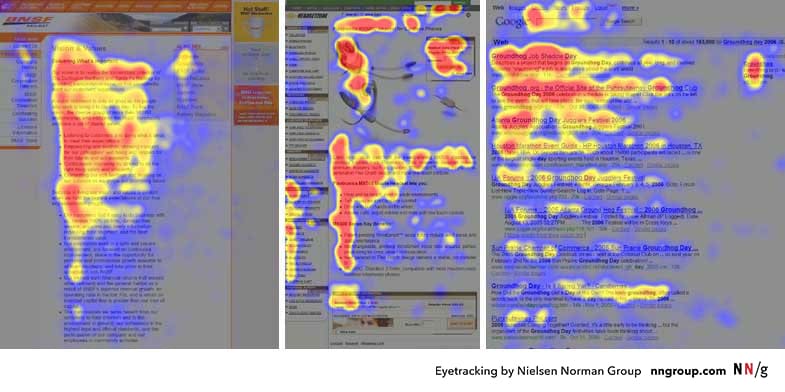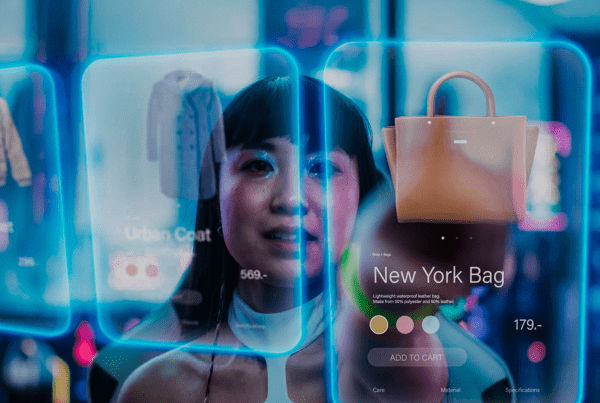
Sandra Caravana
– Copywriter –
It’s all over LinkedIn: should we or should we not send our resumes in word so that Artificial Intelligence (AI) systems in human resources can value our skills more? AI is at the service of recruiters, just like hospital triage. If we do it to hire, why not use AI to profile our clients?
The marriage of Artificial Intelligence and Digital Marketing is more than a movie. It is a documentary.
First, we clarify the concepts.

Sandra Caravana
– Copywriter –
It’s all over LinkedIn: should we or should we not send our resumes in word so that Artificial Intelligence (AI) systems in human resources can value our skills more? AI is at the service of recruiters, just like hospital triage. If we do it to hire, why not use AI to profile our clients?
The marriage of Artificial Intelligence and Digital Marketing is more than a movie. It is a documentary.
First, we clarify the concepts.
What is Artificial Intelligence?
It is not a myth, but it is not a recent thing either. If we see AI as a concept, we easily realize that it is the logical expression of technological evolution. We want machines to help us in our daily lands, from the invention of the automobile to the clothes dryer. We use these machines for a higher quality of life – or better use of our time. When we explain to youngsters the difference between hardware and software, we make the analogy with our body: hardware is the physical part and software is the brain. In 1940, mathematician Alan Turing developed a machine that could break secret Nazi codes created by another machine, patented by Arthur Scherbius and known as Enigma, during World War II. To learn more about the story, you can watch the movie THE IMITATION GAME.
Turing considered the father of computing, created in the 1950s Turing Test: a hypothetical test to analyze whether or not a piece of software is as intelligent as a human being – the so-called imitation game. Did he create algorithms? Maybe. Turing’s great innovation was to create a machine that could think like us, to save time. And in any area of our lives, time is money.
 Source: IMDB
Source: IMDB
If AI simulates human thinking, what can it do for my business?
Starting from this premise, AI in digital marketing is a method of collecting data from customers – and future customers – with the goal of anticipating their next step and improving their journey as a consumer. It analyzes customer behavior, to suggest (and even decide) a personalized marketing strategy for that individual. AI can thus help build a better and more appropriate marketing strategy for your business.
Too much theory? Let’s get to examples.

Source: Pixabay Sounds like the most basic thing
Remember when, in 2019, you were browsing through your favorite sporting goods website, and you were undecided between two sneakers for doing the roads to Santiago? ‘We’ll make a trek to the store and talk to the salesperson. But what if the salesperson is online with you? In 2022, all retail companies will use CHATBOTS. Yes, they are those dialog boxes that appear in the corner of the screen (preferably in the lower right corner) and ask you if you need help.
But this is AI in the service of Digital Marketing in small-scale, albeit rapidly growing, ways:
 Source: 14 Real Life Chatbot Examples to Implement your Bot Strategy
Source: 14 Real Life Chatbot Examples to Implement your Bot Strategy
Responses can be automated: many stores choose to have response options (like a questionnaire) and thus direct the customer to their goal. With some availability, some businesses may have an employee assigned to respond to the customer, but as a general rule, the first message is always the child of AI.
Continuing in the realm of words and language, we also find AI in copywriting. Words sell. And in the digital world, words create curiosity and curiosity drives the customer to purchase. Those who write for e-commerce are always 2 updating their SEO (search engine marketing) strategies and analyzing keywords to generate conversions.
How to sell a baby crib without always saying you sell baby cribs?
There is an information structure and architecture. Not only do we not read the information in the same way, but we don’t read with the same structure when the text is online, compared to a pamphlet. What if we have a tool that helps us organize all this information?
Yes, we do, with the help of AI.
Platforms like PERSADO aim to make your website texts more attractive. For email marketing and other forms of direct communication with the customer (such as messages), the PHRASEE platform customizes your message. A very successful platform in Portugal for designers is Figma, whose suggestions always meet the user’s perspective: UX/UI design.
These are three examples of the use of natural language processing (NLP): it allows technology to understand what a human being speaks or writes and formulate understandable answers, reconciling with the findings of eye-tracking studies, which prove that we read in E or F, from left to right.
 Source: Nielsen Norman Group
Source: Nielsen Norman Group
AI is at the service of digital marketing, not only through words but also through images. Virtual reality is a reality today. And not only in games. During the acute phase of the pandemic, many museums inserted, in their websites, virtual reality platforms that made it possible to visit without leaving home.
Augmented reality is a digital immersion feature, with 3D images that interact with a real-world environment. If we can visit a museum, we can also buy. This augmented reality option is frankly useful when we are talking about purchases not susceptible to exchange. Robbialac has a 3 color simulator available to the customer so that he can try several paints without fear of taking risks. As customers, we can visualize our choice before we physically enjoy it, and as a brand, we reduce our customer’s dissatisfaction rate.
 Source: Pixabay
Source: Pixabay
For the more creative (or for fun, learning, and developing aesthetic sensibility), the DALL-E app creates realistic images from a textual description.
My store is more intelligent than yours
We can talk about intelligent stores for two reasons:
1- When they understand the customer’s pains;
2- When they study the customer’s behavior.
Why do we abandon items in the cart? Why do we click on a backpack, see all the colors available, read the description, see what material it is made of, and then not buy it?
AI bundles all this information. It is our digital footprint. And by it, the brand can analyze the customer’s expectations. The “shopping cart abandonment” parameter is so important that there are brands that send us a personalized email with the message “you forgot to finalize your purchase!” or more creative messages like “your chosen items are feeling abandoned”’ It all depends on the voice of the brand, but no one ignores an abandoned cart.
Data Analysis – everything we do and think
After this more creative part of images and words, AI has its weight here in the analysis of data about the customer. With the right strategy, which involves the choice of parameters, we were even able to conclude that it would be feasible to make a breakfast cereal-flavored ice cream.
We already know that we have a digital footprint. We know that our search engine (mainly Google) is trained to our personality and tastes. But how do we group and analyze this data? How do they manage to send an email with personalized suggestions to each customer? A good analysis of consumer behavior can dictate the success of your business. This AI software groups organizes and establishes connections with all the acquired data:
– Personal data: age, where you live, if you have children, and how old are they;
– Online behavior: which websites do you visit the most, which online stores do you buy the most, how much time do you spend researching products online, which newsletter do you subscribe to, which social media accounts do you follow, what kind of posts do you make on social media, etc;
– Customer behaviors more specific to each brand: what they bought, why they decided to buy item A and not item B, average cart value, the average amount bought regularity of purchases, and course, abandoned carts.
The famous A/B tests are not only for measuring the level of customer satisfaction. We can, with the right strategy, decide the color and tone of voice of our brand. And with these results, we can understand our customer’s tastes (which means we can personalize the communication) and create the perfect audience for our business.
Creating the perfect audience is, in 2022, the big challenge of AI, relying on the best consumer experience/journey.
The Challenges of AI in Digital Marketing
All of the above strategies and platforms are mostly used by retail companies. Why? Because they have a structure that can support the costs of purchasing and licensing these AI systems. Of course, these companies already consolidated in the world market have their perfect audience created, but it is a massive one. Their growth is due, in part, to these artificial intelligence tools articulated with digital marketing strategies.
But then we buy the license of a data analysis tool and that’s it?
No. AI also needs learning time.
AI in digital marketing is not just about collecting data, but also about turning that data into conclusions. How is a digital tool going to relate organization/brand goals to customer preference, trending history, and the context in which it all happens? With training, testing, and a few glitches in between. And for all this you need TIME.
And can I do whatever I want with the data I have collected?
No. AI and Digital Marketing are also covered by the General Data Protection Regulation (GDPR). This regulation has to be part of the marketing strategy itself and you have to train your data analysis tool to know how to use it ethically. To do this, it is necessary to choose wisely the sources to be used. A data privacy standards strategy is chosen here.
Ok, I already have a GDPR policy. Can I move forward?
Calm down. AI needs a strategy, just like your business. It needs goals and partners. Yes, even to do this data analysis you may need outside help. This way, the evaluation of the data will be more reliable and impartial.
So you will know the best place to advertise, which images and text to use, and you can even customize the communication for your customers.
We all have a different Spotify and Netflix interface: both offer useful suggestions that unite the goals of the applications with the user’s trends and history, using sound and images.
Okay, okay. We have talked enough about the customer. Let’s talk about money.
Sure. You can use AI in your business to find out what the best price is for your products and services. AI can be used to poll your competitors’ prices and the expectations of your ideal audience. This ensures that you will get a return on investment.
If AI does all that, will I lose my job?
There is a study that suggests that 6 out of 10 marketing experts may see their jobs replaced by intelligent marketing technology. Let’s not cause panic: we will await further literature on the subject.
The Office for National Statistics shows that (provisional data) in 100 marriages, 91% end in divorce. The marriage between Digital Marketing and AI continues to bear fruit and profits. But if it is perfect…






 Source:
Source: 




